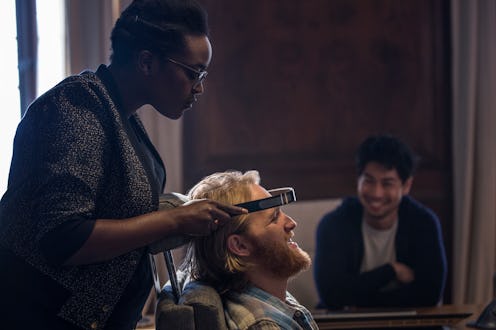
The great irony of Black Mirror is that it's an anthology series about the horrors of technology that most people watch through the technology the show is warning them against. Many people, like myself, are marathoning the newly released third season of Black Mirror through a roommate's PlayStation 4 or other video game console equipped with a Netflix subscription. But, after watching the Season 3 episode "Playtest," chances are you'll want to be as far away from any video game console for a while. The episode envisions a terrifying future where our collective love of games begins to blur the line between fantasy and reality — but is the "Playtest" video game from Black Mirror real, or is the idea itself entirely fantastical? Spoilers below.
As viewers learn at the end of the episode, everything that happened after Cooper's phone rang during the initial playtest was a result of the synapses in his brain firing off — a sort of horrific dying vision of the consequences of failing to turn one's phone off. However, the idea is still not entirely far-fetched. The technology presents an "augmented reality" that projects virtual objects over a real environment. The horror game in "Playtest" is a combination of a lot of technology that exists at this very moment. Here's a look at the games that could have inspired the playtest.
Until Dawn: Rush Of Blood
The most apparent connection between "Playtest" and modern video gaming is the growing popularity of VR, or Virtual Reality, games. Games in which the player puts on a headset over their eyes and inserts themselves into the world of the game. Horror has become an extremely popular genre in the medium, especially with the hit Until Dawn: Rush Of Blood, which puts players in the seat of a terrifying roller coaster.
Pokémon Go
A large part of the technology presented in "Playtest" goes a step beyond virtual reality — becoming something called augmented reality. Instead of putting a headset on the player and taking them to a whole other world, augmented reality projects virtual objects onto the real world and chances are you've already played a basic version of an augmented reality game in the summer of 2016. The Pokémon Go app projects itself over the real world, even allowing players to take pictures of the Pokémon as if they were right there in front of them. The whack-a-mole game that is presented in "Playtest" is a lot closer than you may think.
Nevermind
The scariest part of the game presented in "Playtest" is that the game actually goes into your mind and mines your memories for what you are afraid of. In "Playtest" it drew on everything from a fear of spiders to a high school bully to Cooper's fear of caring for his mother who has Alzheimer's disease. While no game is that advanced yet, the game Nevermind uses biofeedback software to alter the game to match how the player is feeling. By collecting physical and emotional biofeedback, the game changes to amplify the experience for the player. Within the next two decades, it's possible that all games will be tuned into how the player is feeling and altering the experience to best suit each individual player.
"Playtest" creates a terrifying picture of the future of video games — a game that turns an individual's brain into the playing field. While the nightmarish experience Cooper goes through is far off from reality, thrill-seekers like him will likely rise to the occasion to play a game like the one featured on Black Mirror the moment it is released. If nothing else, just remember to keep your phone off when playing.
Images: Laurie Sparham/Netflix; Giphy